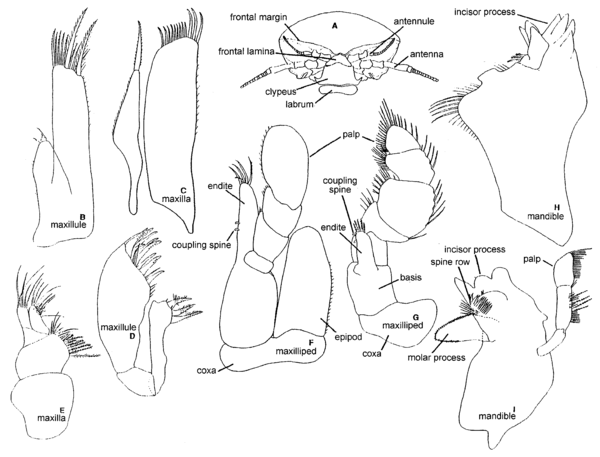- aesthetasc(s)
-
A long, tubular, sensory seta having thin cuticle, found on the antennula or antenna. Aesthetascs may have a chemosensory function, because males generally have more of these structures than females [Wilson, 1989].Sensory seta covered by delicate cuticle, often projecting from antenna or antennule. (Syn. olfactory hair, esthetasc, esthete...) [McLaughlin, 1980].Simple, tubular, thin-walled, chemosensory seta often found on the antennular flagellum [Holdich and Jones, 1983].Spinelike cuticular processes often occurring in clumps or rows and functioning in chemoreception, usually located on the antennules [Brusca and Brusca, 2002].(Order Cladocera):One in a tuft of sensory projections at tip of each antennule. (Syn. esthete, olfactory seta) [Stachowitsch, 1992].(Class Cephalocarida):Elongate sensory projection at tip of each antennule. (Syn. esthete) [Stachowitsch, 1992].(Order Cumacea):One in a series of sensory projections on main flagellum of antennule [Stachowitsch, 1992].(Order Tanaidacea):One in a series of sensory projections on flagella of antennules [Stachowitsch, 1992].(Order Decapoda):One in a series of small sensory projections on outer flagellum of antennule. (Syn. esthetasc, esthete, olfactory hair) [Stachowitsch, 1992].(Order Amphipoda):One in a series of thin-walled sensory projections on antennule. See: calceolus [Stachowitsch, 1992].(Order Isopoda):One in a series of sensory projections on antennules. (uniramous, biramous, triramous) [Stachowitsch, 1992].(Order Isopoda):Thin-walled chemosensory seta usually found on antennular flagellum [Wetzer et al. 1997].(
 ):Nomenclature of isopod cephalon (A). Examples of isopod mouth appendages: Idoteidae (B, C, F, H); Cirolanidae (D, E, G, I). [Wetzer et al. 1997](Order Isopoda):Thin-walled sensory seta usually on flagellum of antennule [Kensley and Schotte, 1989].(Order Leptostraca):One in a series of sensory projections on antennules and ocasionally also on antennae [Stachowitsch, 1992].(Subclass Copepoda):A thin-walled, sensory element with putative chemoreceptive function, found on the antennules [Boxshall and Halsey, 2004].(Subclass Copepoda):A transformed seta of antenna 1 or another oral appendage of copepodids. An aesthetasc usually has a sclerotized base but otherwise is poorly sclerotized; it often is considered to have a chemosensory function [Ferrari and Dahms, in press].(Subclass Copepoda):One in a series of small sensory projections along antennule. (Syn. esthetasc, esthete) [Stachowitsch, 1992].(Subclass Mystacocarida):Small sensory projection at tip of each antennule. (Syn. aesthete) [Stachowitsch, 1992].(Class Ostracoda):One in a series of small sensory projections along antennule or antenna; considered to be modified setae [Stachowitsch, 1992].(Class Remipedia):One of numerous robust, long sensory projections aggregated in several dense rows at base of antennules (on pad on first article of peduncle); directed posteriorly and partially covering antennae. (Syn. esthetasc, esthete, olfactory hair) [Stachowitsch, 1992].(Order Thermosbaenacea):One of several senory projections on larger of two flagellaf antennule [Stachowitsch, 1992].(Order Euphausiacea):One in a series of small sensory projections on each antennule [Stachowitsch, 1992].
):Nomenclature of isopod cephalon (A). Examples of isopod mouth appendages: Idoteidae (B, C, F, H); Cirolanidae (D, E, G, I). [Wetzer et al. 1997](Order Isopoda):Thin-walled sensory seta usually on flagellum of antennule [Kensley and Schotte, 1989].(Order Leptostraca):One in a series of sensory projections on antennules and ocasionally also on antennae [Stachowitsch, 1992].(Subclass Copepoda):A thin-walled, sensory element with putative chemoreceptive function, found on the antennules [Boxshall and Halsey, 2004].(Subclass Copepoda):A transformed seta of antenna 1 or another oral appendage of copepodids. An aesthetasc usually has a sclerotized base but otherwise is poorly sclerotized; it often is considered to have a chemosensory function [Ferrari and Dahms, in press].(Subclass Copepoda):One in a series of small sensory projections along antennule. (Syn. esthetasc, esthete) [Stachowitsch, 1992].(Subclass Mystacocarida):Small sensory projection at tip of each antennule. (Syn. aesthete) [Stachowitsch, 1992].(Class Ostracoda):One in a series of small sensory projections along antennule or antenna; considered to be modified setae [Stachowitsch, 1992].(Class Remipedia):One of numerous robust, long sensory projections aggregated in several dense rows at base of antennules (on pad on first article of peduncle); directed posteriorly and partially covering antennae. (Syn. esthetasc, esthete, olfactory hair) [Stachowitsch, 1992].(Order Thermosbaenacea):One of several senory projections on larger of two flagellaf antennule [Stachowitsch, 1992].(Order Euphausiacea):One in a series of small sensory projections on each antennule [Stachowitsch, 1992].
Crustacea glossary. Natural History Museum of Los Angeles County. 2011.
